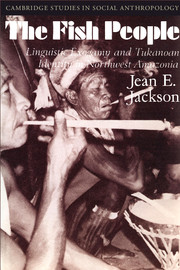Book contents
- Frontmatter
- Contents
- List of figures, maps, and tables
- Preface
- Acknowledgments
- Note on orthography
- 1 Purpose and organization of the book
- 2 Introduction to the Central Northwest Amazon
- 3 The longhouse
- 4 Economic and political life
- 5 Vaupés social structure
- 6 Kinship
- 7 Marriage
- 8 Tukanoans and Makú
- 9 The role of language and speech in Tukanoan identity
- 10 Male and female identity
- 11 Tukanoans' place in the cosmos
- 12 Tukanoans and the outside world
- 13 Conclusions: themes in Tukanoan social identity
- Notes
- Glossary
- References
- Index
- CAMBRIDGE STUDIES IN SOCIAL ANTHROPOLOGY
2 - Introduction to the Central Northwest Amazon
Published online by Cambridge University Press: 05 June 2012
- Frontmatter
- Contents
- List of figures, maps, and tables
- Preface
- Acknowledgments
- Note on orthography
- 1 Purpose and organization of the book
- 2 Introduction to the Central Northwest Amazon
- 3 The longhouse
- 4 Economic and political life
- 5 Vaupés social structure
- 6 Kinship
- 7 Marriage
- 8 Tukanoans and Makú
- 9 The role of language and speech in Tukanoan identity
- 10 Male and female identity
- 11 Tukanoans' place in the cosmos
- 12 Tukanoans and the outside world
- 13 Conclusions: themes in Tukanoan social identity
- Notes
- Glossary
- References
- Index
- CAMBRIDGE STUDIES IN SOCIAL ANTHROPOLOGY
Summary
Ecological setting
The Vaupés region, roughly the size of New England, lies approximately between the equator and 1° north latitude, and between 69° and 71° west longitude (see Map I). It is bisected by the Colombia–Brazil border, and in terms of political boundaries its territory forms part of the Brazilian Territorio Nacional do Amazonas and the Colombian Comisaría del Vaupés. The latter comprises 90,625 square kilometers (Instituto Geográfico “Agustín Codazzi,” 1969). Humid, tropical rainforest covers the entire region. This vegetation is typical of the whole western extension of the interfluvial Guiana Highlands (Moser and Tayler, 1963, p. 440), of which the Vaupés forms part, being more densely wooded and shorter than the canopy forests typical of the Amazon basin itself. The cerros, or flat-topped and domed hills that dot the landscape, date from the Guiana Shield epoch (Reichel-Dolmatoff, 1975, p. 64). Visible from far away, these cerros stand out in an otherwise largely undifferentiated extent of forest, river, and smaller hills. Their prominence makes them important landmarks for Tukanoans, as are the swamps dominated by the mirití palm (Mauritia flexuosa). The land generally slopes eastward, and high open lands and exposed rock and caves are typical of the western sections. Savanna is found both to the south and north but not in the region itself.
The major rainy season lasts from April to August, the lesser for a few weeks in October or November (Instituto Geográfico “Agustín Codazzi,” 1969, p. 67).
- Type
- Chapter
- Information
- The Fish PeopleLinguistic Exogamy and Tukanoan Identity in Northwest Amazonia, pp. 13 - 25Publisher: Cambridge University PressPrint publication year: 1983



